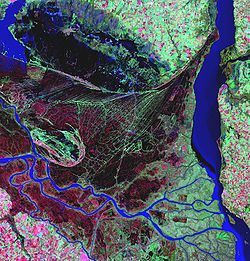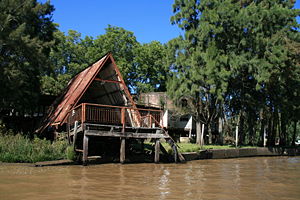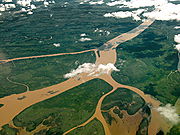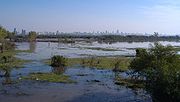
Paraná Delta
Encyclopedia

River delta
A delta is a landform that is formed at the mouth of a river where that river flows into an ocean, sea, estuary, lake, reservoir, flat arid area, or another river. Deltas are formed from the deposition of the sediment carried by the river as the flow leaves the mouth of the river...
of the Paraná River
Paraná River
The Paraná River is a river in south Central South America, running through Brazil, Paraguay and Argentina for some . It is second in length only to the Amazon River among South American rivers. The name Paraná is an abbreviation of the phrase "para rehe onáva", which comes from the Tupi language...
in Argentina
Argentina
Argentina , officially the Argentine Republic , is the second largest country in South America by land area, after Brazil. It is constituted as a federation of 23 provinces and an autonomous city, Buenos Aires...
. The Paraná flows north–south and becomes an alluvial
Alluvium
Alluvium is loose, unconsolidated soil or sediments, eroded, deposited, and reshaped by water in some form in a non-marine setting. Alluvium is typically made up of a variety of materials, including fine particles of silt and clay and larger particles of sand and gravel...
basin (a flood plain) between the Argentine provinces
Provinces of Argentina
Argentina is subdivided into twenty-three provinces and one autonomous city...
of Entre Ríos
Entre Ríos Province
Entre Ríos is a northeastern province of Argentina, located in the Mesopotamia region. It borders the provinces of Buenos Aires , Corrientes and Santa Fe , and Uruguay in the east....
and Santa Fe
Santa Fe Province
The Invincible Province of Santa Fe, in Spanish Provincia Invencible de Santa Fe , is a province of Argentina, located in the center-east of the country. Neighboring provinces are from the north clockwise Chaco , Corrientes, Entre Ríos, Buenos Aires, Córdoba, and Santiago del Estero...
, then emptying into the Río de la Plata
Río de la Plata
The Río de la Plata —sometimes rendered River Plate in British English and the Commonwealth, and occasionally rendered [La] Plata River in other English-speaking countries—is the river and estuary formed by the confluence of the Uruguay River and the Paraná River on the border between Argentina and...
.
The Paraná Delta has an area of about 14000 square kilometre and starts to form between the cities of Santa Fe
Santa Fe, Argentina
Santa Fe is the capital city of province of Santa Fe, Argentina. It sits in northeastern Argentina, near the junction of the Paraná and Salado rivers. It lies opposite the city of Paraná, to which it is linked by the Hernandarias Subfluvial Tunnel. The city is also connected by canal with the...
and Rosario
Rosario
Rosario is the largest city in the province of Santa Fe, Argentina. It is located northwest of Buenos Aires, on the western shore of the Paraná River and has 1,159,004 residents as of the ....
, where the river splits into several arms, creating a network of islands and wetland
Wetland
A wetland is an area of land whose soil is saturated with water either permanently or seasonally. Wetlands are categorised by their characteristic vegetation, which is adapted to these unique soil conditions....
s. Most of it is located in the jurisdiction of Entre Ríos, and parts in the north of Buenos Aires Province
Buenos Aires Province
The Province of Buenos Aires is the largest and most populous province of Argentina. It takes the name from the city of Buenos Aires, which used to be the provincial capital until it was federalized in 1880...
. It is conventionally divided into three parts:
- the Upper Delta, from the DiamanteDiamante, Entre RíosDiamante is a city in the west of the province of Entre Ríos, Argentina, on the eastern shore of the Paraná River. It has about 20,000 inhabitants as per the . It is the head town of the Diamante Department....
– Puerto Gaboto line to Villa ConstituciónVilla ConstituciónVilla Constitución is a city in the province of Santa Fe, Argentina, and the head town of the Constitución Department. It is located on the south-western banks of the Paraná River between the courses of the Arroyo Pavón and the Arroyo del Medio, about 214 km south from the provincial capital,...
; - the Middle Delta, from Villa Constitución to the Ibicuy IslandsIbicuy IslandsThe Ibicuy Islands are a maze of low-level islands in the east of the Paraná Delta, within Entre Ríos Province, Argentina. They are located between the Paraná and Uruguay Rivers. The islands are part of the Islas del Ibicuy Department and have scattered but important settlements, like their...
; - the Lower Delta, from the Ibicuy Islands to the mouth of the river.

Tonne
The tonne, known as the metric ton in the US , often put pleonastically as "metric tonne" to avoid confusion with ton, is a metric system unit of mass equal to 1000 kilograms. The tonne is not an International System of Units unit, but is accepted for use with the SI...
s of suspended sediment
Sediment
Sediment is naturally occurring material that is broken down by processes of weathering and erosion, and is subsequently transported by the action of fluids such as wind, water, or ice, and/or by the force of gravity acting on the particle itself....
(about half of it coming from the Bermejo River
Bermejo River
The Bermejo River is a river in South America that flows from Bolivia to the Paraguay River in Argentina. The river is generally called Bermejo in spite of its different names along its way, but it also has its own Native American names; in Wichí it is called Teuco, and in Guaraní it is called Ypitá...
through the Paraguay River
Paraguay River
The Paraguay River is a major river in south central South America, running through Brazil, Bolivia, Paraguay, and Argentina...
) and advances several tens of metres (50 or up to 90, according to different sources) per year over the Río de la Plata. It is the world's only river delta that is in contact not with the sea but with another river.
The Lower Delta was the site of the first modern settlements in the Paraná-Plata basin and is today densely populated, being the agricultural and industrial core of Argentina and host to several major ports. The main course of the Paraná lies on the west of the delta, and is navigable downstream from Puerto General San Martín
Puerto General San Martín
Puerto General San Martín is a small city in the province of Santa Fe, Argentina, located within the metropolitan area of Greater Rosario, about north from the center of the city of Rosario, on the western shore of the Paraná River...
by ships up to Panamax
Panamax
Panamax and New Panamax are popular terms for the size limits for ships traveling through the Panama Canal. Formally, the limits and requirements are published by the Panama Canal Authority titled "Vessel Requirements"...
kind.
Rivers of the delta
Among the many arms of the river are the Paraná Pavón, the Paraná Ibicuy, the Paraná de las Palmas, the Paraná Guazú and the smaller Paraná Miní and Paraná Bravo.The Paraná Pavón is the first major branch. It has a meandering course that starts on the eastern side, opposite Villa Constitución. Between the main Paraná and the Paraná Pavón lie the Lechiguanas Islands. The Paraná Pavón flows east and then turns south to be continued by the Ibicuy, which itself gives origin to the smaller Paranacito River, a tributary of the Uruguay River that passes by Villa Paranacito
Villa Paranacito
Villa Paranacito is a town in the southeast corner of the province of Entre Ríos, Argentina, head town of the Islas del Ibicuy Departament. It is located in the third section of the delta at the heart of the low-lying Ibicuy Islands in the Paraná Delta and is the administrative centre for the...
.
The Paraná de las Palmas starts around the mouth of the Paraná Ibicuy, downstream from Baradero
Baradero
Baradero is the oldest town of Buenos Aires Province, Argentina, being founded in 1615. It is the head town of the Baradero Partido.It is located on the bank of the Baradero River which is a tributary of the Paraná River.-External links:...
, flowing west into the province of Buenos Aires and then turning southeast again. The main course is continued by the other major branch, the Paraná Guazú. In turn, the Paraná Guazú sprouts two east-flowing branches in the territory of Entre Ríos: first the Paraná Bravo, and then the Paraná Miní.
Climate
Due to the low altitude and the ubiquitous presence of water, the Paraná delta is subject to a particular climate within the climate zones of the Pampas. As in the entire region, there are four distinct seasons; however, the Delta has slightly warmer nights, milder winters and higher humidity, which allows some warmer-weather species to thrive.Summers are hot and often muggy; with daily highs between 28°C (82F) and 32°C (90F), and nights between 16°C (61F) and 20°C (68F). Heat waves are common, yet they are not as intense as in central Argentina, and usually temperatures will not go much above 36°C (97F), although they have reached 40°C (104F) in the past. Thunderstorms are common and can bring heavy rain and much cooler weather. As in the entire Pampas region, summers are "cut" by short, cool periods when southerly Pampero winds blow.
March is already noticeably cooler than the summer, and April is characterized by very pleasant weather: highs range from 21°C (70F) to 25°C (70F), nights from 10°C (50F) to 14°C (57F), and May is already generally cool, with chilly nights.
Winter runs from late May to late August. Temperatures usually range from 13°C (55F) to 18°C (64F), while nights go from 3°C (37F) to 7°C (45F), with lower precipitation but higher cloudiness and relatively common fog. As in the entire Pampas region, there are often brief, mild spells in the winter when the temperatures might reach 25°C (77F), followed by much colder weather and frosty nights. Temperatures usually reach 0°C several times a year, yet they rarely fall much lower than -3°C (27F), with record lows approaching -7°C (19F). However, generally speaking, the windy, humid weather makes it feel significantly chillier than indicated by real temperatures.
Spring is usually delightful, yet very sudden changes may occur: summer-like and winter-like temperatures often alternate, and there may be a large difference between day and night temperatures. It is also the season most prone to violent weather. October has the same average temperatures as April, with slightly cooler nights, yet extremes of heat and cold are more likely: frost may rarely occur, as may temperatures of 35°C (95F), sometimes within the same week.
Precipitation in the region ranges from 1,000 mm to 1,400 mm, with two peaks in late spring / early summer, and late summer / early fall, and a drier, yet cloudier winter.
Ecology


Marsh Deer
The Marsh Deer, Blastocerus dichotomus , is the largest deer species from South America reaching a length of and a height of at the rump. It is found in Argentina, Bolivia, Brazil, Uruguay and Paraguay...
, the capybara
Capybara
The capybara , also known as capivara in Portuguese, and capibara, chigüire in Venezuela, Colombia, and Ecuador ronsoco in Peru, chigüiro, and carpincho in Spanish, is the largest living rodent in the world. Its closest relatives are agouti, chinchillas, coyphillas, and guinea pigs...
, the Neotropical River Otter
Neotropical River Otter
The Neotropical Otter , Lontra longicaudis, is an otter species found in Central America, South America and the island of Trinidad....
, the Pampas Cat
Pampas Cat
The Colocolo is a small spotted and striped cat native to the west Andean slope in central and northern Chile. Until recently it included the more widespread Pampas Cat and Pantanal Cat , and some maintain these as subspecies of the Colocolo...
, the jaguar
Jaguar
The jaguar is a big cat, a feline in the Panthera genus, and is the only Panthera species found in the Americas. The jaguar is the third-largest feline after the tiger and the lion, and the largest in the Western Hemisphere. The jaguar's present range extends from Southern United States and Mexico...
, the coypu
Coypu
The coypu , , also known as the river rat, and nutria, is a large, herbivorous, semiaquatic rodent and the only member of the family Myocastoridae. Originally native to subtropical and temperate South America, it has since been introduced to North America, Europe, Asia, and Africa, primarily by...
and the Red-faced Guan
Cracidae
The chachalacas, guans and curassows are birds in the family Cracidae.These are species of tropical and subtropical Central and South America. One species, the Plain Chachalaca, just reaches southernmost Texas in the USA...
(Penelope dabbenei), some of them endangered.
Protected areas
The Predelta National ParkPredelta National Park
The Predelta National Park is a national park of Argentina, located in south-west of the province of Entre Ríos, 6 km south from Diamante, in the Argentine Mesopotamia, at the beginning of the Paraná River Delta...
, created in 1992, protects a sample of the Upper Delta. It is located in the southwest of Entre Ríos, 6 km south of Diamante, and has an area of 24.58 km², occupied by low-lying islands subject to flooding, as well as lagoons and swamps.
The Biosphere Reserve of the Paraná Delta is composed of the second and third sections of the Islands of the San Fernando
San Fernando Partido
San Fernando is a partido of Buenos Aires Province, Argentina, in the north of Greater Buenos Aires. Its capital is San Fernando. It is 28 km. from the city of Buenos Aires.-Population distribution :...
Delta, located just north of Buenos Aires
Buenos Aires
Buenos Aires is the capital and largest city of Argentina, and the second-largest metropolitan area in South America, after São Paulo. It is located on the western shore of the estuary of the Río de la Plata, on the southeastern coast of the South American continent...
. It was declared a natural reserve in 2000 by UNESCO
UNESCO
The United Nations Educational, Scientific and Cultural Organization is a specialized agency of the United Nations...
.
It takes up 886 km², of which 106 km² are the core protected area. It is an area rich in biodiversity, including species that find their southernmost limit of distribution, which makes the area interesting for the conservation of genetic diversity. The main human activity in this part of the delta is the exploitation of the willow forest for commercial purposes, and human impact is low. The region has suffered from a loss of human population and today there are only 3,600 inhabitants living there (2001). The establishment of the Biosphere Reserve aims at revitalizing the economy of the region at the same time as conserving the natural and cultural values of the area and support the investigation and study of the ecosystem with the possibilities of national and international investment in projects of sustainable growth and the grouping of the region in reference of organic cultivation and varied ways of land-forest production with certification of ecological quality.
See also
- Tigre, Buenos AiresTigre, Buenos AiresTigre is a town in the Buenos Aires Province, Argentina, situated in the north of Greater Buenos Aires, north of Buenos Aires city. Tigre lies on the Paraná Delta and is an important tourist and weekend attraction, easily reached by bus and train services, including the scenic Tren de la Costa...
- Villa Paranacito, Entre RíosVilla ParanacitoVilla Paranacito is a town in the southeast corner of the province of Entre Ríos, Argentina, head town of the Islas del Ibicuy Departament. It is located in the third section of the delta at the heart of the low-lying Ibicuy Islands in the Paraná Delta and is the administrative centre for the...

